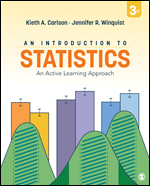An Introduction to Statistics
An Active Learning Approach
Kieth A. Carlson - Valparaiso University, USA
Jennifer R. Winquist - Valparaiso University, USA
Watch a video from the authors on the new edition here!
Available formats
See what’s new to this edition by selecting the Features tab on this page. Should you need additional information or have questions regarding the HEOA information provided for this title, including what is new to this edition, please email sageheoa@sagepub.com. Please include your name, contact information, and the name of the title for which you would like more information. For information on the HEOA, please go to http://ed.gov/policy/highered/leg/hea08/index.html.
For assistance with your order: Please email us at textsales@sagepub.com or connect with your SAGE representative.
SAGE
2455 Teller Road
Thousand Oaks, CA 91320
www.sagepub.com
Instructor Resource Site
edge.sagepub.com/carlson3e
For additional information, custom options, or to request a personalized walkthrough of these resources, please contact your sales representative.
LMS cartridge included with this title for use in Blackboard, Canvas, Brightspace by Desire2Learn (D2L), and Moodle
The LMS cartridge makes it easy to import this title’s instructor resources into your learning management system (LMS). These resources include:
- Test bank
- Editable chapter-specific PowerPoint® slides
- Answers to the textbook’s Reading Questions
- Answers to the textbook’s Activity Questions
- Additional Practice Tests and Answers
- All tables and figures from the textbook
You can still access all of the same online resources for this title via the password-protected Instructor Resource Site.
Student study site
edge.sagepub.com/carlson3e
The open-access Student Study Site makes it easy for students to maximize their study time, anywhere, anytime. It offers flashcards that strengthen understanding of key terms and concepts, as well as learning objectives that reinforce the most important material.
- More emphasis on interpreting statistics. New coverage of “4 Pillars of Scientific Reasoning” (Hypothesis Testing with a Continuous p value, Practical Importance with Effect Size, Population Estimation with Confidence Intervals, and Methodology and Scientific Literature) helps students think about statistical results and create well-supported scientific conclusions,
- Enhanced activity questions. Most enhanced questions now use a fixed-choice format to provide better feedback to students to help them identify areas of improvement.
- A new emphasis on interpreting p values continuously rather than dichotomously (i.e., using critical value cut offs) follows an approach advised by most statisticians.
- More software options (including free, simple-to-use JASP and jamovi) as well as SPSS are supported. Instructors can also use this textbook with any statistics program they prefer.
- A streamlined organization with fewer chapters covers the same topics in more depth by combining central tendency and variability into a single chapter, integrating confidence intervals into multiple chapters, and introducing hypothesis testing with single sample t rather than z for a sample mean.
- Expanded coverage of effect sizes includes all pairwise comparisons (including ANOVAs).
- More instruction on writing results using APA style, particularly in the t-test and ANOVA chapters, gives readers confidence to convey their data.
- Integrative assignments in the related t, independent t, one-way ANOVA, and correlation chapters reinforce the different information researchers obtain from significance tests, effect sizes, and confidence intervals, encouraging students to think like researchers.
- A new textbook website contains useful resources for students and instructors, including answer keys for the activities, practice tests for each chapter, instructions for using SPSS, JASP, and jamovi, data files for all activities in the book, a test bank, and lecture slides.
- Embedded reading questions and empirically developed activities in each chapter help students extract key concepts and enable them to learn by doing.
- Carefully developed scenarios, problem sets, and quiz questions in each chapter help students test their knowledge and master the material.
- A decision tree at the end of the book helps students choose the correct statistical tool for hypothesis testing.

